From autumn into winter overnight......waking up to three inches of snow was a surprise. How would the local wildlife respond?
From autumn into winter overnight......waking up to three inches of snow was a surprise. How would the local wildlife respond?
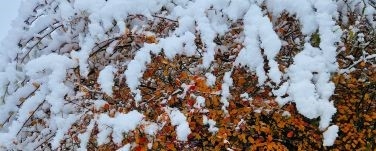
Our old Cotoneaster bush with its gloriously coloured leaves weighed down by fresh snow. NB
As usual when it snows, the number and variety of birds coming into gardens for food increases markedly.
In my garden, two pied wagtails arrived, chaffinch and blackbird numbers immediately increased and three redwings dropped in to feed on the halved apples I had thrown out.
Less welcome were three magpies but they seemed more intent on chasing each other than coming down to feed.
A couple of stock doves joined the collared doves (up to eight) and wood pigeons (five) taking mixed seed from the small patches where I'd cleared the snow and two smart nuthatches bullied the tits from the hanging seed feeders.
I've also noticed in the previous few days a big increase in the number of blackbirds feeding along local lane-sides. These are probably mainly incomers from the continent whereas all the male blackbirds in the garden had bright yellow beaks suggesting they were local birds. Continental males tend to have black beaks.
Of course some species never come into gardens. Among those are stonechats, a pair of which turned up a couple of miles away on my local patch just before the snow. They will struggle to find insect food if these freezing conditions persist much longer.
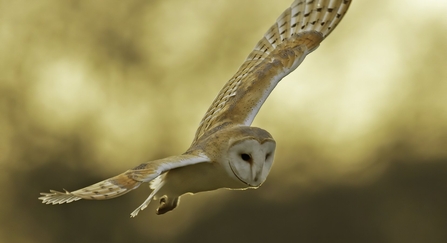
Barn owl - Russell Savory
Barn owls are another species which suffers when snow is on the ground for days on end. They simply can't get to their small mammal prey.
British Wildlife magazine
My monthly copy of British Wildlife arrived midweek with a lesser spotted woodpecker photo on the cover and an article about it inside.
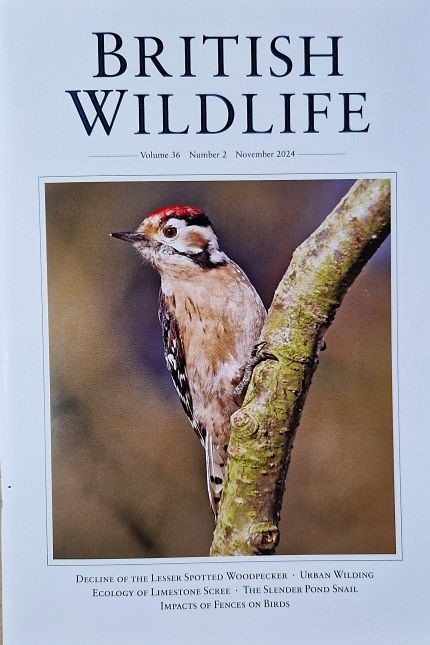
'Lesser spots' are in sharp decline.
In the 1970s when dutch elm disease resulted in thousands of dead, standing elms, lesser spots increased as a direct response. They fed on the many saproxylic (wood-eating) insects which took advantage of a super abundance of dead timber.
Since that brief rise, woodpecker numbers have fallen year by year and as yet, there's no sign that ash die back will have a similar beneficial effect. Perhaps there simply aren't the numbers of insects around any longer to feed on the dead wood?
Research points to poor chick survival as the likely cause of this tiny woodpecker's demise due mainly, it seems, to a lack of insect food.
Relying on mature (and preferably dead or dying) trees, no amount of tree planting will help its short term recovery whereas ring barking some trees and rewetting some woods just might.
Lesser spots are a species I've had quite a lot to do with so I have a vested interest in their future, if they have one that is.
Dung
The dung of grazing animals is a subject I rarely see mentioned but I make no apology for doing so for a second week running.
Holding an outdoors conference on dung beetles seems rather niche until you realise just how important these ecosystem engineers are.
Watch the eloquent Dr Sarah Beynon and some dung and beetle-loving farmers talking about them and if you are ever talking to farmers make sure you raise the subject of the toxic medications so routinely used to control grazing animals gut parasites.
The Dung Beetle Conference 2024 .

A (Dexter) cow pat under attack - NB
Dung beetles have been calculated to have an economic benefit to farming in the UK equivalent to over £300 million per year.
I bet Mr. Clarkson has never heard about their crucial role!
DOS AR
Also delivered to my door this week was the 2023 Annual Report of the Derbyshire Ornithological Society (DOS). It's always a very professional publication, this time with articles about ring ouzels on a farm bordering Cheshire by Mark Cocker et al and another about Birds of Conservation Concern in the county.
DaNES Journals
A day later and copies of the latest two journals of the Derbys and Notts Entomological Society (DaNES) dropped through the letterbox.
I was especially interested in the Odonata (dragonflies) and Orthoptera (grasshoppers, crickets etc) reports for 2023.
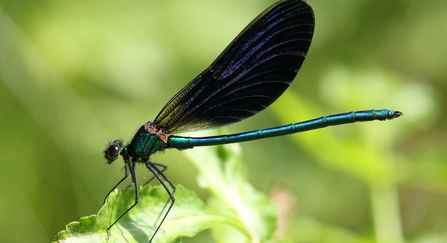
Beautiful demoiselle - Vaughn Matthews
Other local natural history and species groups do invaluable work.
To name a few: DOS, DaNES, Sorby NH Soc (if you live within reach of Sheffield), Derbys Amphibian and Reptile Group, Derbys Mammal Group, Derbys Bat Group, Buxton Field Club, Derby and Long Eaton Nat. Hist. Societies, Bakewell Bird Study Group, Carsington Birders, etc.
Whistling wigeon
Wigeon are medium sized duck, smaller than mallard but bigger than teal. They make very distinctive whistling calls both in flight and when landed.
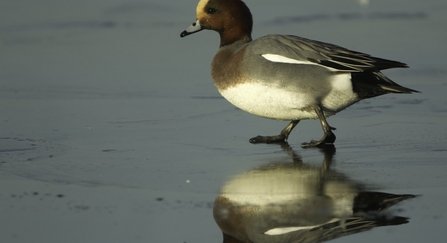
Wigeon (Anas Penelope) - Danny Green/2020VISION
A flock of 185 wigeon at Willington Wetlands was notable (if transitory) but elsewhere numbers have been dropping year by year.
Wyver Lane NR used to be reliable for them but in the absence of any grazing on the surrounding fields this summer, these mainly grass-eating duck no longer have the short, bankside turf they need. Not surprising then that they have moved elsewhere.